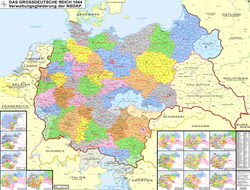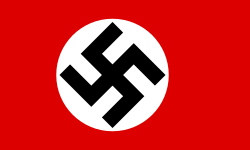| Gau Franconia | |||||||||
|---|---|---|---|---|---|---|---|---|---|
| Gau of Nazi Germany | |||||||||
| 1929–1945 | |||||||||
 Map of Nazi Germany showing its administrative subdivisions ( Gaue and Reichsgaue ). Gau Franken in dark brown. | |||||||||
| Capital | Nuremberg | ||||||||
| Population | |||||||||
• 17 May 1939 [1] | 1,065,122 | ||||||||
| Government | |||||||||
| Gauleiter | |||||||||
• 1929–1940 | Julius Streicher | ||||||||
• 1940–1942 (acting) | Hans Zimmermann | ||||||||
• 1942–1944 (acting) | Karl Holz | ||||||||
• 1944–1945 | Karl Holz | ||||||||
| History | |||||||||
| 1 March 1929 | |||||||||
| 8 May 1945 | |||||||||
| |||||||||
| Today part of | Germany | ||||||||
Gau Franconia (German: Gau Franken) was an administrative division of Nazi Germany in Middle Franconia, Bavaria, from 1933 to 1945. Before that, from 1929 to 1933, it was the regional subdivision of the Nazi Party in that area. Originally formed as Middle Franconia (German: Mittelfranken) in 1929, it was renamed Franconia in 1936.

